Viewing: Blog Posts Tagged with: Irene Latham, Most Recent at Top [Help]
Results 1 - 7 of 7
Blog: A Year of Reading (Login to Add to MyJacketFlap)
JacketFlap tags: Irene Latham, Live Your Poem, Add a tag
Blog: Teaching Authors (Login to Add to MyJacketFlap)
JacketFlap tags: writing longhand, Poetry, Poetry Friday, poem, Book Giveaway, children's poems, handwriting, Irene Latham, April Halprin Wayland, Add a tag
.
Howdy, Campers and Happy Poetry Friday!
(and, Irene! Congratulations on the upcoming publication
of your first poetry collection for children
which has gotten starred reviews from SLJ and Kirkus!)
by April Halprin Wayland
It’s a sound idea—
a muscular,
a strong one.
It’s strapping, able-bodied one
it’s beefy—
it’s a long one.
It’s a strapping noun,
it’s her fingers plunked down
with a most decisive click.
It’s a piece of punctuation
that’s sealed—
it sticks.
by April Halprin Wayland
liquid longhand sometimes flows
or oozes slow
it drains from a dream
to its place on the page
where it will not linger
no, the pen seeps deeper
beneath each line
where longhand makes its own design
Blog: Kid Lit Reviews (Login to Add to MyJacketFlap)
JacketFlap tags: Children's Books, Picture Book, Poetry, NonFiction, Favorites, children's book reviews, Millbrook Press, Irene Latham, African animals, Library Donated Books, 6 Stars TOP BOOK, Top 10 of 2014, Lerner Publishing Group Inc., Anna Wadham, Add a tag
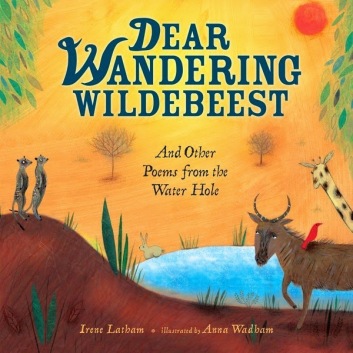 x
x
Dear Wandering Wildebeest: And Other Poems from the Water Hole
Written by Irene Latham
Illustrated by Anna Wadham
Millbrook Press 8/01/2014
978-1-4677-1232-3
Age 4 to 8 32 pages
x
x

x
x
x
x
“Welcome wildebeest
and beetle,
oxpecker and lion.
This water hole is yours.
It offers you oasis
beside its shrinking shores.
“Spend a day at a water hole in the African grasslands. From dawn to nightfall, animals come and go. Giraffes gulp, wildebeest graze, impalas leap, vultures squabble, and elephants wallow. Irene Latham’s gorgeous poems are accompanied by additional facts that provide further details about the animals and their environment. Imaginative illustrations from Wadham complete this delightful collection.”
Review
Dear Wandering Wildebeest, is composed of 15 poems about wild African animals, a glossary of possibly unusual words, and a section of advanced reading, enhanced by beautiful illustrations of the animals and the African land in which they live.
If you like giraffes, monkeys, lions, and elephants, you are in luck. There are also rhinoceros, small nightjars, vultures, marabou storks, oxpeckers, and, of course, wildebeest. Don’t worry, there are many more animals than that in this wonderful book. The pages look like the African Plains have jump onto the paper, leaving nothing bare. The beautiful skies change with the day, sometimes the dark blue of midnight or the rosy shade of dusk.
Some of the poems rhyme and some do not, but all are easy to read aloud. Impala Explosion swiftly jumps off the reader’s tongue.
“Wind lifts
grass shifts
eyes search
legs lurch
twig pop
grazing stops
ears twitch
tails hitch
peace shatters . . .”
—Impala Explosion, (partial poem) by Irene Latham © 2014
x
x
Kids will love the poems. They will understand them all, and any word that is foreign to them is most likely sitting in the glossary waiting to spread some understanding. If you like the aforementioned giraffes, Ms. Latham wrote a triptych in its honor. What is a triptych, you ask? I have no idea, but the glossary knows. Let’s check.
“triptych: a work of art divided into three sections”
That would be correct. The giraffe’s poem is divided into three sections:
Craving,
Caution, and
Courage.”
Feeling parched, the giraffe craves a drink. Giraffe’s must be cautious, as it has no idea what other animals will be at the water hole. It could be dangerous. To quench its thirst, the giraffe must be courageous and confident because other animals will pounce on a weak animal. Giraffes are cool creatures. If the poem does not convince you of this, read the information box in the lower left side of the spread.
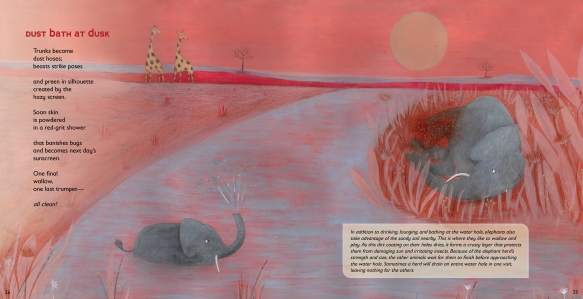
Each spread has an information box containing interesting things about the animal or animals illustrated. I really like the information the author/poet adds to the spread, much of it new information that I found fascinating. For instance, did you know the impala could jump as high as eight feet? Eight feet! That is high enough to clear the privacy fence in your backyard, if you have one, and have two feet between the top of the fence and the impala’s belly. How about this, in one year, the wildebeest travels—looking for food—more than 800 miles across the Serengeti. This is equivalent to you traveling across the state of Kansas, east to west (or west to east) twice, or the state of Rhode Island from north to south (or south to north) a whopping 20 times! The extra information is very interesting.
The illustrations are simply gorgeous. The African animals depicted in detail and the landscapes of various colors are easily as beautiful as the animals—except maybe snakes. I do not like snakes. If you do, they are covered and you will think they are beautiful. Check out each animal’s eyes. There is always something going on that draws their attention. (I think that darn snake is looking at me!) There is so much to see on each spread.
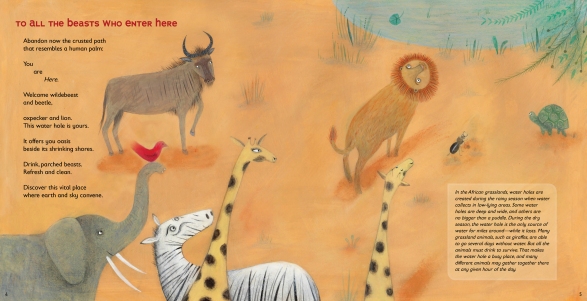
Dear Wandering Wildebeest is one of those picture books that will delight nearly 99% of those most who read its poems and view its lovely art. Kids, you will love the animals, the sometimes-quirky poems, the illustrations, and all the interesting side information about life at an Africa watering hole for the wild creatures that need it for survival. If you love poetry and animals, Dear Wandering Wildebeest is a book is for you. It is really that simple. With school right around the corner, Dear Wandering Wildebeest is perfect book for show and tell or light research for a book report on an African watering hole and the animals that depend upon it.
DEAR WANDERING WILDEBEEST: AND OTHER POEMS FROM THE WATER HOLE. Text copyright © 2014 by Irene Latham. Illustrations copyright © 2014 by Anna Wadham. Reproduced by permission of the publisher, Millbrook Press, Minneapolis, MN.
Purchase a copy of Dear Wandering Wildebeest: And Other Poems from the Water Hole at Amazon—B&N—Book Depository—Millbrook Press—your favorite bookstore.
x
Learn more about Dear Wandering Wildebeest: And Other Poems from the Water Hole HERE.
Meet the author/poet, Irene Latham, at her website: http://www.irenelatham.com/
Meet the illustrator, Anna Wadham, at her website: http://annawadham.blogspot.com/
You can find more poetry at the Millbrook Press website: https://www.lernerbooks.com/
Millbrook Press is a division of Lerner Publishing Group, Inc.
x
Also by Irene Latham

The Sky Between Us

Don’t Feed the Boy
Read Review HERE.
Also by Anna Wadham

The Ant and the Big Bad Bully Goat
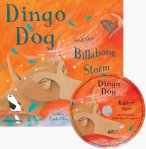
Dingo Dog and the Billabong Storm
x
x

x
x
Copyright © 2014 by Sue Morris/Kid Lit Reviews
Filed under: 6 Stars TOP BOOK, Children's Books, Favorites, Library Donated Books, NonFiction, Picture Book, Poetry, Top 10 of 2014 Tagged: African animals, Anna Wadham, children's book reviews, Irene Latham, Lerner Publishing Group Inc., Millbrook Press, picture book, poetry
Blog: Kid Lit Reviews (Login to Add to MyJacketFlap)
JacketFlap tags: relationships, nature, monkeys, sketching, neglect, Roaring Brook Press, middle grade books, wild animals, zoos, middle grade school, Stephanie Graegin, Zoo director, zoo life, abusive husband, boas, captive animals, head elephant trainer, home schooled, MacMilian Books, illustration, kids, friendship, drawing, Middle Grade, animals, Favorites, family life, arts, elephants, first love, abuse, fires, middle grade book review, Irene Latham, barns, howlers, 5stars, Add a tag
5 Stars Don’t Feed the Boy by Irene Latham Illustrated by Stephanie Graegin Pages: 288 Ages: 8 to 12 ……………………. Back Cover: No kid knows more about zoo life than Whit. That’s because he sleeps, eats and even attends home-school at the Meadowbrook Zoo. It’s one of the perks of having a mother who’s the [...]![]()
Blog: Caroline by line (Login to Add to MyJacketFlap)
JacketFlap tags: the writing life, inspiration, quotes, Irene Latham, Sheila O'Connor, J. Anderson Coats, Add a tag
- Irene Latham's Plot is a Verb postcard
- a flyer from my first author event
- a photo of a statue erected to honor pioneer women
- two quotes from J. Anderson Coats
- a silly VIP name tag from my 2007-2008 fourth graders (they gave me a "most likely to be a famous author" award)
- a great last name -- Folkenflick (any NPR listeners recognize this?)
- an anonymous, kind response during a First Pages reading session at SCBWI-MI 2004
- a card Schwartz and Wade sent along with my very own copy of May B.
- a song called Why Do We Hunger For Beauty? that always makes me cry
- a faded purple 3x5 that holds May B.'s original plot line
- a picture of me as a mid-grader
- pins for various books and debut author groups
- a tag from a Caroline Rose jacket...too fun to throw away!
- a heart necklace on a yarn chain
- a portrait by my nine-year-old
- endurance
- patience
- commitment
- passion
Blog: Teaching Authors (Login to Add to MyJacketFlap)
JacketFlap tags: Book Giveaway, Irene Latham, Esther Hershenhorn, Guest Teaching Author, Add a tag
How swell to introduce another Guest Teaching Author to our TeachingAuthors readers: Birmingham, Alabama poet and debut novelist Irene Latham.
Leaving Gee’s Bend is just such a tale.
Come meet Irene in the Q & A interview she recently granted me.
1. How did you become a TeachingAuthor?
2. What’s a common problem/question that your students have and how do you address it?
Interestingly, one of the problems I’ve encountered in my poetry workshops is writer’s block, which seems to be more a “brain freeze” related to performance anxiety. I’ve always found coming up with ideas to be the easy part. So for me to discover this is often the hard part for students…. Well, I’ve learned to be very specific in my prompts. That seems to help. Also, reminding them that the only absolute in poetry is that there is no absolute.
3. Would you share a favorite writing exercise for our readers?
Oh my goodness, I could go on for days! Here’s one I was just reminded of in a workshop with author Kerry Madden. It’s deceptively simple, but guaranteed for good results: Think of your favorite secret hiding place. What do you see? What do you hear? What do you smell? What do you taste? What do you feel against your skin?
4. What one piece of advice do you have for teachers?
Remember: writing involves trust. For kids to open up on paper, they need to feel safe. Which means, don’t worry so much about form as substance. Praise kids for their effort, their creative thought… overlook poor grammar and punctuation errors. As soon as you start focusing on the nitpicky stuff, they will disengage emotionally. And the whole point is for them to dig deep, to discover something about themselves and their world as they put words on the page.
5. Can you share the Moment you knew you were a writer?
For many years writing was my secret life. Even my husband of twenty years says he didn’t know he married a writer. That’s because I didn’t pursue writing as a career in
Blog: Juvenescent (Login to Add to MyJacketFlap)
JacketFlap tags: Rosemary Stimola, Putnam, Stacey Barney, SCBWI Southern-Breeze, Irene Latham, Add a tag
 Irene Latham comes to YA writing from the world of poetry, where she has already published a full-length collection of poems. The book, What Came Before, won an IPPY (Independent Press) Award and was named Alabama State Poetry Society's Book of the Year. I think it’s safe to say Irene is no slouch when it comes to using language! I can’t wait to see how she applies her poetic voice to young adult fiction.
Irene Latham comes to YA writing from the world of poetry, where she has already published a full-length collection of poems. The book, What Came Before, won an IPPY (Independent Press) Award and was named Alabama State Poetry Society's Book of the Year. I think it’s safe to say Irene is no slouch when it comes to using language! I can’t wait to see how she applies her poetic voice to young adult fiction.
Irene will be one of the first Tenners to be published; her book, Leaving Gee’s Bend, will be released by G.P. Putnam's Sons in January of 2010. Here’s the beautiful cover and a short synopsis: A ten year old girl in Depression-era Gee’s Bend, Alabama, sets out to save her sick mother and records her adventures in quilt pieces.
A ten year old girl in Depression-era Gee’s Bend, Alabama, sets out to save her sick mother and records her adventures in quilt pieces.
Now on to the questions!
Can you tell us how did you meet your agent?
I met Rosemary Stimola at an SCBWI Southern-Breeze (AL-GA-MS) conference in October 2006. Or rather, I sat in the back row and listened to her speak. I was too shy to introduce myself. But I really liked her straightforward approach and thought if I ever decided to pursue an agent, she was who I was going to go for. My dream at the time was to be one of those slush-pile miracles, so I had only been subbing to editors--I really hadn’t considered getting an agent until I met Rosemary.
Can you tell us how your book deal happened?
I sent a Gee’s Bend story I’d written in verse (poetry: my comfort zone!) to Rosemary just after the conference. She promptly declined -- said she had a novel-in-verse sitting on her desk that she couldn’t sell. So instead of feeling sorry for myself (well, AFTER feeling sorry for myself), I decided I would rewrite the story in prose. So I worked on that for several months and re-subbed to Rosemary as if we had never had the previous contact. And this time, she said YES and sent it to the editor she had in mind. That editor was Stacey Barney at Putnam, and she really liked the voice of the story but didn’t feel like it was quite fleshed-out enough. (again, I write lots of poetry, which is of course very spare: manuscript was only 17,000 words!) She requested a revision, so I got busy adding meat to those bones. Stacey liked what I did with the story, and at that point Putnam offered a contract.
You’ve had a book of poetry published, was that harder or easier to sell than fiction?
Poetry is a much more elusive animal than fiction. It is extremely difficult to sell because there is virtually no market for poetry. My experience has been with small independent presses where there are no advances and a book is considered a success if it breaks even financially. It’s definitely one of those things you do because you love it. And I do.
What was the inspiration for Leaving Gee’s Bend and how long did it take you to write?
On a trip to New York City in the fall of 2003, my husband and I visited the Quilts of Gee’s Bend exhibit at the Whitney Museum. I was completely enamored of the quilts and the voices of the women from this teeny tiny isolated community that is geographically only 120 miles from my home in Birmingham, Alabama. Couple this fascination with the fact that I am the daughter of an amazing seamstress who very early on put a needle and thread in my hands, and it’s no mystery where this story comes from. The story that sold was the fourth one I had written set in Gee’s Bend. So from the point of seeing the quilt exhibit to the point of sale, it was right at four years. It took me that long to find the story I was meant to tell all along - Ludelphia’s story.
What are you working on now?
I’ve just completed the third draft of another midgrade historical fiction: ESCAPE FROM FIRE MOUNTAIN. It’s set in 1902 Martinique and chronicles the adventures of two girls (one native, one American) during the eruption of Mt. Pelee (an eruption that claimed 30,000 lives). So I’ve zipped that one off to my agent and now I’m working on a contemporary midgrade DON’T FEED THE ANIMALS. It’s set in an Alabama zoo and is about the son of a zoo director mom and elephant keeper dad whose terrible misfortune is that he was born human (with no particular interest in exotic animals).
Did your childhood dreams include being a writer?
According to my Dr. Seuss’ My book About Me, six year old me wanted to be a writer, a mother, a veterinarian…. and a horse trainer for the horse that my sister would ride to victory in the Kentucky Derby. So far that hasn’t happened, but I do write books, live with three sons and over the years have had all manner of pets, including horses, rabbits, goats, chickens, hamsters, parakeets, fish, ferrets, snakes, frogs, turtles, cats, dogs, ants and butterflies.
Do you have any words of wisdom for writers trying to get published?
Be the Little Engine that Could. And instead of getting frantic about a manuscript that is not selling, transfer all that energy into writing the next thing. Every word you write makes you a better writer.
Thanks for the interview, Irene! For more information about Irene Latham, check out her website or blog, or become friend on Facebook. To read her award-winning book, get a copy here.





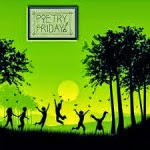





Oh I love this. I need to get me an inspiration board... hmm.
Beautiful. Love everything. And how true are Sheila's 4 words?!
I love your inspiration board!
It's funny. I never planned to make my bulletin board be an inspiration board, but that's what it has become.
What a lovely board! I need to get me one of these.
I know.